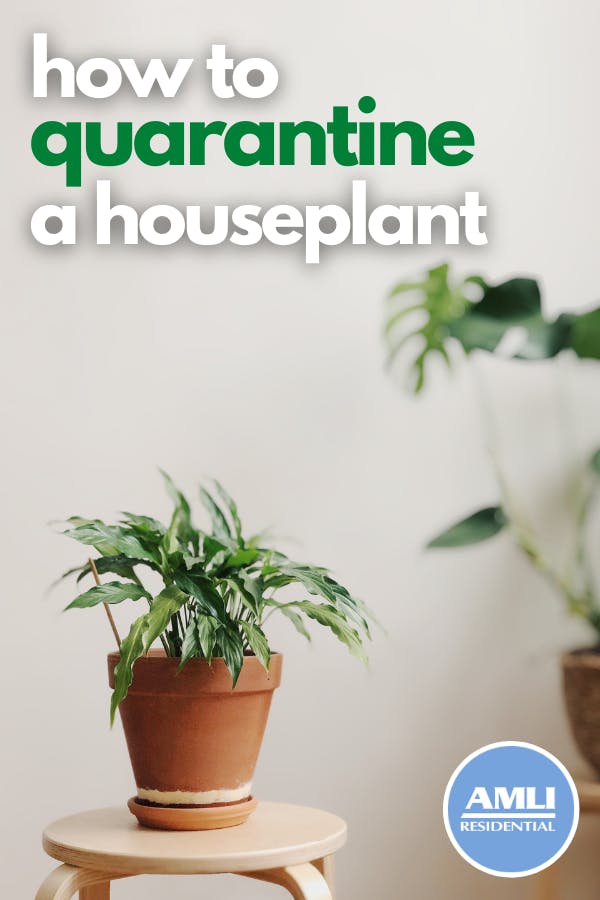We’ve spent more than enough time talking about quarantining these past few years, so much so that the mere mention of it might bring back sour memories from the not-too-distant-past.
But let’s not apply it to ourselves this time ‘round and focus on a totally different kind of quarantining that people have been taking part in for years. Namely, quarantining a houseplant.
Why quarantine a houseplant, you ask? Well, below is everything you need to know about isolating houseplants for the health and safety of all their other, more vulnerable houseplants.
You know, like that time when the entire globe shut down?
How to quarantine a houseplant
Why do we need to quarantine indoor plants?
The main reason we quarantine houseplants is for pest control. The last thing anyone wants is an apartment full of disease-ridden plants that were all infected by one guilty culprit, and quarantining certain houseplants at certain times is vital to preventing issues just like that.
You should quarantine a houseplant every time…:
- You buy a new plant. Greenhouses and plant farms are breeding grounds for plant illnesses because they provide the perfect conditions. There are plenty of other plants, nutritious and moist soil, humid air and protection from the outside elements, all of which are great for growing plants. It’s also a great breeding ground for fungus gnats or spider mites, and if the greenhouse has a pest problem, then it’s likely that your brand new plant has some issues that need to be taken care of.
- You bring in an outside plant. If you keep some outdoor plants inside during the winter (or indoor plants inside in the summer), then bringing them back inside can introduce outdoor bugs to your indoor plants.
- You spot pests. The easiest way to tell if your plant is riddled with pests is to examine it— leaves, soil and all. If you see flies hovering around soil or bugs making themselves cozy on branches, then you need to quarantine every infected plant, as well as other seemingly uninfected ones.
Before you quarantine your houseplant
Before you send off any of your plants to far, lonely corners of your apartment, take some time to really examine your plant and treat it as much as you can.
First, inspect and diagnose your plant. This means checking the undersides of leaves, stems, flowers and soil for any existing pests or diseases. Keep an eye out for bugs that cling to leaves, flies that hover around the plant and mold or fungus around the soil. If there is something there, then knowing what you’re working with will go a long way to fixing it.
Next, spray your plant down very lightly with a gentle mix of soapy water or a sterilizing spray. Don’t make it too strong to kill the plant, of course, but it should have a slight cleaning solution in it for any bugs or grime that’s clinging to your plant.
Finally, take the plant out of the pot and inspect the roots. Do you see any mold? Signs of rot? Strange coloring or, God forbid, maggots crawling through the roots? Whether you do or don’t, it’s a good idea to loosen the soil a bit with your fingers and allow it to fall out of the root structure, then re-pot the plant with clean, fertilized soil before moving ahead.
During quarantine
Generally, a quarantined plant needs to be isolated for about 40 days to ensure it’s at full health.
If you can keep your plant in a separate room with no other plants, then that is great and will be most convenient for you. Care for that isolated plant as you would normally, and keep an eye out for any pests or diseases that may pop up over time. If you need to, take a photo of it every week to check on its progress.
If you’re short on space and have just too many plants to move around, then there are still ways you can effectively quarantine your plant.
Use a large, transparent plastic bag to cover your plant, leaving enough space for decent air circulation within the bag (don’t worry about suffocating it!). Secure the bag to the planter using a rubber band and move the plant out of direct sunlight where it could potentially fry under the plastic. Don’t worry about watering the plant as often — or, possibly, at all — because the leaves won’t lose any moisture to transpiration while in the bag. Just like one of those 8th grade science class experiments, right?
After quarantine
After your plant has completed its forty-day time-out, reinspect the plant as you did before isolating it.
If your plant is showing symptoms of disease or pest infection, then tackle those accordingly and rest easy knowing that your other beloved plants were spared similar fates. All thanks to you, of course!
If your plant looks good and healthy, then wonderful! You can introduce your new leafy friend to your other plants and allow it to integrate with the rest of your apartment home.
It’s worth it!
Why bother quarantining a perfectly good looking houseplant for over a month, you might ask? Because the alternative is far more time consuming, costly and painful than allowing a plant to sit alone for a few weeks. Trust us, it’s not worth losing all your beloved plants because one plant from a big box store was infested with fungus gnats (can you tell we’re totally not still bitter about it?).
You’ll be glad you did it!
Good luck!
Pin it!

Featured photo courtesy Pixabay/kaboompics


 View All Posts by Colleen Ford
View All Posts by Colleen Ford